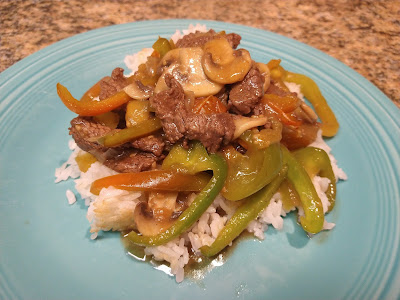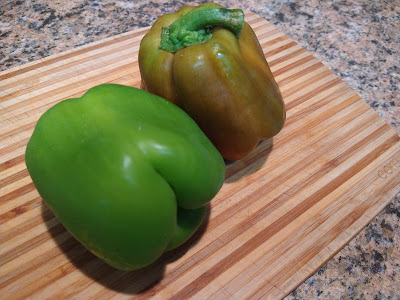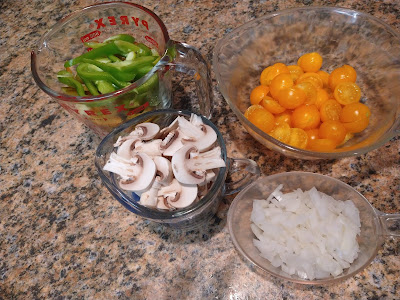
Recipe: Pepper steak with a California twist -- cherry tomatoes

Cherry tomatoes and wine add complexity to this
pepper steak stir fry. (Photos: Debbie Arrington)
|
Bell peppers don’t have to be perfect for pepper steak. They can be lopsided, sunburned or under size. Trim off any bad spots and thinly slice the rest.
Pepper steak is a Chinese American staple. This version has a distinctly California twist; cherry tomatoes and wine add complexity to the sauce. (Chopped full-size tomatoes can be substituted.) For this recipe, yellow cherry tomatoes were used, adding some extra sweetness.
Two tips: Start with a frozen steak, slightly defrosted. It’s much easier to slice crosswise, very thin. (For this recipe, a bistro filet – teres major or shoulder cut – was used, but other cuts work well, too.)
Chop first, then cook. Prepare vegetables before starting to stir fry. It may seem like there will be plenty of time for chopping while cooking, but stir fry demands constant attention (and stirring).
Want a spicier pepper steak? Substitute some sliced Anaheim or similar peppers for part of the bells.
Pepper steak
Makes 4 servings
 |
| Imperfect peppers work just fine in pepper steak. |
Ingredients:
1 pound beef steak
Marinade:
2 tablespoons cornstarch
1 tablespoon sugar
3 tablespoons soy sauce
2 tablespoons wine or sherry
1 tablespoon red wine vinegar
½ teaspoon red pepper flakes
½ teaspoon ginger
For stir-fry:
4 tablespoons oil, divided
2 cloves garlic, minced
½ cup onions, chopped
1 cup mushrooms, sliced
2 cups bell pepper, thinly sliced
1 cup cherry tomatoes, halved
½ cup chicken broth
Instructions:
 |
|
Prep all the ingredients before starting to cook.
|
Slice steak across the grain into thin slices, trimming off any fat.
Prepare marinade. In a glass or ceramic bowl, combine cornstarch and sugar. Whisk in soy sauce, wine and vinegar. Add pepper flakes and ginger.
Add beef slices to marinade. Cover each slice well. Set aside.
In a large wok or frying pan, heat 2 tablespoons oil over medium heat. Sauté garlic until fragrant (about 30 seconds). Add chopped onion and sauté until translucent, about 2 minutes. Add mushrooms, sauté another 2 minutes. Add bell peppers, sauté another 2 minutes. With a slotted spoon, remove vegetables from wok and set aside.
Return wok to heat and add remaining oil. Swirl oil around wok to cover as much of surface as possible. Remove beef slices from marinade, retaining soy mixture. Add beef slices to wok, working quickly and distributing evenly around wok surface. Stir fry beef until lightly browned on both sides, about 2 minutes. Add tomatoes to beef, stir and cover wok; cook 2 minutes.
Return vegetables to wok and stir into beef-tomato mixture. Add chicken broth and any remaining marinade. Stir, then cover for 2 minutes.
Uncover and stir, scraping up any brown bits into sauce. Adjust seasoning and consistency, if necessary.
Serve hot over rice.
Comments
0 comments have been posted.Sacramento Digs Gardening to your inbox.
Food in My Back Yard Series
May 6: Maintain soil moisture with mulch for garden success
April 29: What's (already) wrong with my tomato plants?
April 22: Should you stock up on fertilizer? (Yes!)
April 15: Grow culinary herbs in containers
April 8: When to plant summer vegetables
April 1: Don't be fooled by these garden myths
March 25: Fertilizer tips: How to 'feed' your vegetables for healthy growth
March 18: Time to give vegetable seedlings some more space
March 11: Ways to win the fight against weeds
March 4: Potatoes from the garden
Feb. 25: Plant a fruit tree now -- for later
Feb. 18: How to squeeze more food into less space
Feb. 11: When to plant? Consider staggering your transplants
Feb. 4: Starting in seed starting
Sites We Like
Garden Checklist for week of May 4
Enjoy this spring weather – and get gardening!
* Plant, plant, plant! It’s prime planting season in the Sacramento area. Time to set out those tomato transplants along with peppers and eggplants. Pinch off any flowers on new transplants to make them concentrate on establishing roots instead of setting premature fruit.
* Direct-seed melons, cucumbers, summer squash, corn, radishes, pumpkins and annual herbs such as basil.
* Harvest cabbage, lettuce, peas and green onions.
* In the flower garden, direct-seed sunflowers, cosmos, salvia, zinnias, marigolds, celosia and asters. (You also can transplant seedlings for many of the same flowers.)
* Plant dahlia tubers. Other perennials to set out include verbena, coreopsis, coneflower and astilbe.
* Transplant petunias, marigolds and perennial flowers such as astilbe, columbine, coneflowers, coreopsis, dahlias, rudbeckia and verbena.
* Keep an eye out for slugs, snails, earwigs and aphids that want to dine on tender new growth.
* Feed summer bloomers with a balanced fertilizer.
* For continued bloom, cut off spent flowers on roses as well as other flowering plants.
* Add mulch to the garden to maintain moisture. Mulch also cuts down on weeds. But don’t let it mound around the stems or trunks of trees or shrubs. Leave about a 6-inch to 1-foot circle to avoid crown rot or other problems.